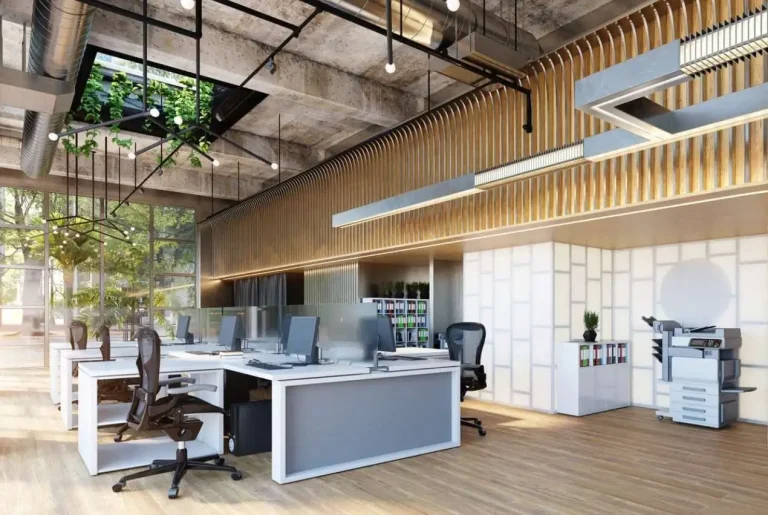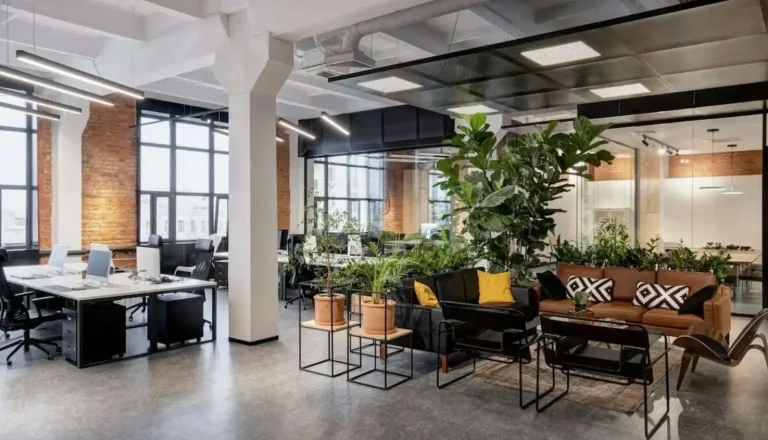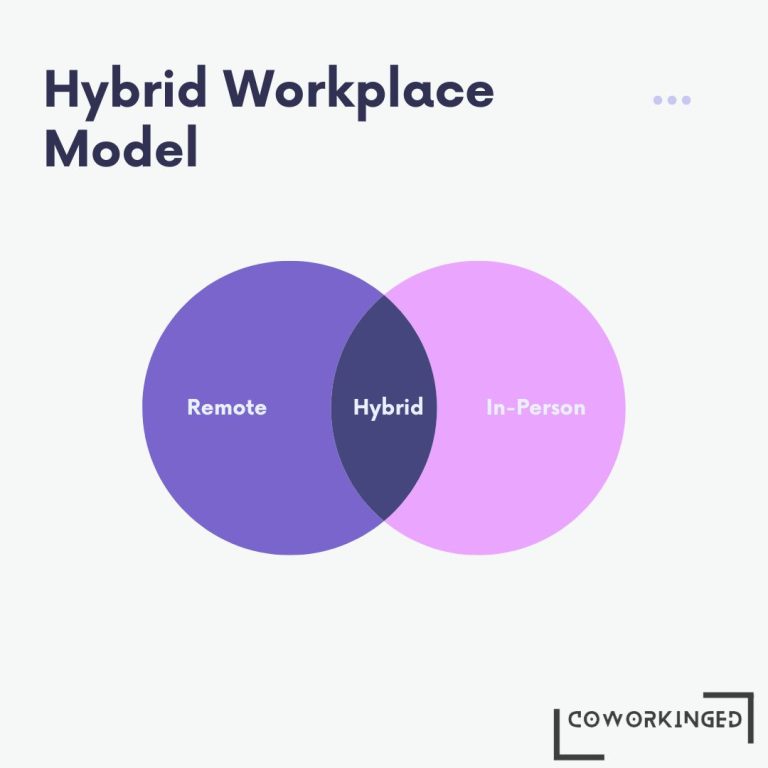What is Coworking?
I. Introduction:
Imagine a workspace where freelancers, remote workers, entrepreneurs, and even corporate teams come together under one roof, sharing not just desks but ideas, creativity, and a sense of community. Welcome to the world of coworking spaces!
In recent years, there’s been an incredible surge in the popularity of coworking spaces. No longer confined to the realm of startups and freelancers, these shared workspaces have transformed the way people work. In coffee-scented corners and open-plan offices, a revolution is brewing.
In this article, we’ll take a deep dive into the fascinating realm of coworking spaces. We’ll uncover their origins, explore the myriad advantages and potential drawbacks, and look at the diverse community that calls them home. By the end, you’ll have a comprehensive understanding of what coworking spaces are all about and why they’ve become an integral part of today’s evolving work landscape. So, grab your favorite brew and let’s embark on this coworking adventure together!
II. Definition and Explanation
Defining the Cozy Chaos of Coworking Spaces
At its core, a coworking space is like a bustling, communal bazaar of work. It’s a shared workspace where individuals from various professional backgrounds converge to get stuff done. But it’s so much more than that.
The Primary Purpose
The primary purpose of a coworking space is to provide a flexible, collaborative, and inspiring environment for work. Unlike traditional offices, which can be rigid and isolating, coworking spaces offer a dynamic ecosystem where people can thrive both professionally and socially.
Diverging from Traditional Offices
So, how do these spaces differ from the cubicles and corner offices of traditional workplaces? It’s all in the vibes.
In a coworking space, you’ll find a mix of freelancers, remote workers, small startups, and even corporate teams, all sharing the same roof. It’s a melting pot of ideas, where the boundaries between companies blur, and collaboration becomes second nature. Traditional offices, on the other hand, are often confined to a single company or organization.

Key Features that Define the Magic
Now, let’s peel back the layers to reveal what makes coworking spaces truly special:
- Shared Workspace: This is the beating heart of coworking. Rows of desks, comfy chairs, and cozy nooks make up the shared workspace. It’s where the magic happens, and the atmosphere hums with productivity.
- Amenities Galore: Forget about dealing with printer jams or rationing your coffee. Coworking spaces spoil you with amenities. Think high-speed internet, meeting rooms, kitchens, and even lounges to recharge in style.
- Community Spirit: Beyond the physical space, coworking spaces nurture a sense of community. You’re not just renting a desk; you’re joining a vibrant ecosystem of professionals. Networking events, workshops, and shared projects are the norm.
- Flexibility Rules: No rigid contracts or restrictive leases here. Coworking spaces offer flexibility, allowing you to choose the membership that suits your needs, whether it’s a day pass, a month, or longer. It’s your workspace on your terms.
- Inspirational Design: Many coworking spaces are a feast for the eyes, designed to spark creativity and innovation. Expect an eclectic mix of styles, from industrial chic to cozy minimalism.
In essence, coworking spaces are like the modern-day equivalent of a Renaissance salon, where brilliant minds converge, ideas collide, and collaboration thrives. They’re where work feels less like a chore and more like a dynamic adventure.
As we venture further into the world of coworking, we’ll unravel the historical evolution, dive into the advantages and disadvantages, and explore the diverse tapestry of individuals and businesses that call these spaces home. Stay with us on this coworking journey!
III. Historical Evolution
Tracing the Roots: Hackerspaces and Entrepreneurs’ Centers
Coworking spaces may seem like a recent phenomenon, but their roots trace back to innovative concepts that emerged in the late 20th century. One of these pioneering ideas was the “hackerspace.” In the mid-1990s, hackerspaces began to spring up in various cities, notably starting with one in Berlin. These community-operated venues attracted coders, scientists, and software engineers. They served as hubs for sharing cutting-edge ideas, comparing code, and hosting social events and seminars.
Around the same time, in 1999, Apple launched its iconic iBook, a portable and powerful laptop. This technology, with its colorful clamshell design, was a common sight in coffee shops, study halls, and wherever freelancers gathered to work. It marked a significant shift towards more mobile and flexible work arrangements.
The Emergence of Entrepreneurs’ Centers
In 2002, an “entrepreneurs center” opened in Vienna, known as Schraubenfabrik. This center, situated inside a rundown factory, provided a shared open-plan office space that nurtured a growing community of startups, freelancers, and architects. It played a pivotal role in shaping the early coworking movement. Schraubenfabrik continues to thrive today and proudly calls itself the “mother of coworking.”
Birth of the Modern Coworking Space
Fast forward to 2005 when a software engineer named Brad Neuberg introduced a new kind of shared workspace. Located in the Spiral Muse, a feminist collective in San Francisco’s Mission District, the San Francisco Coworking Space was an early prototype of the modern coworking space. Neuberg’s vision aimed to create a workspace that was not only productive but also social and community-driven.
The 2008 global financial crisis and the subsequent recession transformed the world of work. With businesses downsizing and job losses on the rise, a wave of workers turned to self-employment, reshaping the employment landscape. This shift towards independent work contributed to the growing popularity of coworking spaces.
By 2009, the concept of coworking was gaining traction. Several unofficial coworking events took place at South by Southwest (SXSW), forming the foundation of what would later become the “Global Coworking Unconference Conference” (GCUC). By the end of that year, there were an estimated 160 coworking spaces around the world.
WeWork and the Coworking Explosion
In 2010, WeWork, a global leader in the coworking industry, opened its first location in New York City. This 3,000 square-foot coworking space on Lafayette Street featured an industrial aesthetic, wooden floors, and exposed brickwork—a design that has become iconic in many WeWork locations worldwide.
The coworking movement continued to gain momentum, and by 2013, there were an estimated 2,500 coworking spaces worldwide. WeWork expanded rapidly, opening its first space in London in 2014. The company’s growth was relentless, and by 2017, WeWork had launched 90 new locations in 31 cities globally, further fueling the coworking trend.
As of 2019, according to Statistica, there were nearly 19,000 coworking spaces worldwide, showcasing the tremendous growth and acceptance of this innovative way of working.
From Hackerspaces to WeWork, the evolution of coworking spaces has been a remarkable journey. These spaces have transcended their humble beginnings to become dynamic hubs for professionals of all backgrounds. As we continue our exploration, we’ll delve into the advantages and disadvantages of coworking spaces and uncover who exactly is making these spaces their second home. Stick around for more insights into the coworking phenomenon!
IV. Types of Coworking Spaces
Coworking spaces aren’t a one-size-fits-all deal. They come in a variety of flavors, catering to different needs, styles, and professional communities. Let’s take a stroll through the different types you’re likely to encounter:
1. General Coworking Spaces
These are the OGs of the coworking world. General coworking spaces are open to everyone. Freelancers, entrepreneurs, remote workers, and small businesses all gather here to share resources and mingle. They’re like the bustling town squares of the coworking universe, where a diverse mix of professionals converges, each bringing their unique energy to the table.
2. Industry-Specific Spaces
Imagine a coworking space tailor-made for your profession. That’s the beauty of industry-specific coworking spaces. Whether you’re a graphic designer, a healthcare professional, or a blockchain developer, you can find a space that’s not only well-equipped but also filled with like-minded experts. These spaces foster niche communities and offer specialized resources, making them ideal for deep dives into your industry.
3. Corporate Coworking Spaces
Even the corporate world has hopped on the coworking bandwagon. Large companies are embracing coworking spaces to reduce the burden of maintaining traditional offices. Corporate coworking spaces provide flexibility for teams to collaborate and expand into new markets. They also offer an agile solution for large enterprises looking to tap into fresh talent pools without the commitment of long-term leases.
Catering to Diverse Needs
Now, let’s talk about how coworking spaces cater to a smorgasbord of professional needs:
- Freelancers: For freelancers, coworking spaces provide a structured environment that breaks the monotony of working from home. They offer networking opportunities, a sense of belonging, and a professional workspace to meet clients.
- Startups: Small startups find coworking spaces cost-effective and scalable. They can avoid the heavy financial burden of leasing an entire office and, at the same time, benefit from a collaborative environment that fuels innovation.
- Remote Workers: In the age of remote work, coworking spaces act as a bridge between home and the traditional office. Remote workers can maintain a sense of structure and social interaction while enjoying the flexibility to choose their workspace.
- Large Enterprises: For big corporations, coworking spaces are strategic tools. They help in decentralizing workforces, accessing new markets, and streamlining office expenses. Plus, they’re a beacon for attracting top talent.
In essence, coworking spaces are chameleons, adapting to the diverse needs of modern professionals. Whether you’re a lone freelancer seeking community, a startup with dreams of expansion, or a corporate giant in pursuit of flexibility, there’s a coworking space that’s just right for you. It’s a testament to the versatility and innovation of the modern workplace. So, no matter where you fit in the professional puzzle, there’s a coworking space with your name on it.
V. Advantages of Coworking Spaces
Coworking spaces are more than just hip places to work; they’re transformative ecosystems with a treasure trove of benefits. Let’s unravel the advantages that make these spaces so enticing:
1. Flexibility for the Win
In the realm of coworking, flexibility reigns supreme. Say goodbye to long-term leases and rigid office contracts. Coworking spaces offer a variety of membership options, from daily passes to monthly plans. It’s like having a menu of workspaces to choose from, depending on your needs. This flexibility is a lifeline for freelancers, startups, and remote workers, allowing them to scale up or down as their projects evolve.
2. Cost-Effective Brilliance
Coworking spaces are like the Robin Hood of office spaces—they steal from the corporate overheads and give back to the businesses. By sharing resources like office facilities, high-speed internet, and reception services, coworking spaces spread the cost, making it more affordable for young companies on tight budgets. It’s a budget-savvy choice that lets you focus your funds on what truly matters.
3. Community, Connection, Collaboration
Coworking spaces aren’t just about work; they’re about weaving a vibrant tapestry of community. Imagine being surrounded by professionals from various fields, each with their unique skills and insights. Coworking spaces foster an environment where networking isn’t a chore; it’s a way of life. Collaboration happens naturally when you’re rubbing shoulders with creative minds from different backgrounds. These spaces are like catalysts for serendipitous connections and unexpected partnerships.
Related: What Is a Serviced Office?
4. Supercharge Your Productivity
Working from a coworking space can be a turbo boost for your productivity. The presence of other driven individuals around you is a powerful motivator. It’s harder to procrastinate when your neighbor is hustling. Plus, the act of physically traveling to a dedicated workspace helps structure your day and sharpen your focus. Coworking spaces are a game-changer for turning “I’ll do it later” into “I’m getting it done now.”
Real-Life Success Stories
But don’t just take our word for it; let’s peek into a couple of real-life stories:
Meet Lisa: Lisa, a freelance graphic designer, struggled with the isolation of working from home. Then, she discovered a coworking space. Not only did she regain her work-life balance, but she also found clients and collaborators within the coworking community. Her business flourished, all thanks to the dynamic environment of her coworking space.
The Startup Saga: A small software startup faced the challenge of finding an affordable office while they bootstrapped their venture. They joined a coworking space that provided not just workspace but also mentorship opportunities. Fast forward a few years, and that startup transformed into a thriving tech company, all while staying rooted in their coworking community.
These stories illustrate the real-world impact of coworking spaces. They’re not just places to clock in and out; they’re launchpads for success stories.
So, whether you’re seeking flexibility, cost-effectiveness, a community to call home, or a productivity boost, coworking spaces deliver. They’re the secret sauce behind many professionals’ journeys to success. Join the coworking revolution, and who knows what incredible stories you’ll write in your own workspace adventure!
VI. Disadvantages of Coworking Spaces
Coworking spaces might sound like utopias for work, but they do come with a few quirks and challenges. Here are some of the key drawbacks you might encounter:
1. Limited Customization
One of the downsides of coworking spaces is the limited scope for customization. You can’t always tweak the layout, design, or amenities to suit your precise needs. What you see is often what you get. This can be a bit stifling if you have specific requirements, like a particular office setup or specialized equipment.
2. Less Privacy
Coworking spaces thrive on the idea of collaboration and community, but that can sometimes mean less privacy. If you’re working on confidential projects, handling sensitive data, or just value your personal space, the open-plan nature of coworking spaces might make you feel exposed.
3. Noise Levels
While the buzz of activity can be motivating, it can also get quite noisy. Phone calls, discussions, and the occasional ping of a ping-pong ball can disrupt your focus. If you’re someone who needs absolute silence to work, this can be a challenge.
Mitigating the Downsides
Now, let’s talk about how to turn these disadvantages into manageable issues:
- Customization Solutions: If you crave a more personalized workspace, some coworking spaces offer dedicated desks or private offices within their premises. This allows you to enjoy the benefits of a coworking community while maintaining some control over your workspace.
- Privacy Enhancements: For those concerned about privacy, many coworking spaces offer soundproof meeting rooms or private phone booths. These areas provide the solitude you need for confidential calls or focused work.
- Noise-Canceling Headphones: Noise can be a part of the coworking experience, but a good pair of noise-canceling headphones can work wonders. They’ll help you tune out distractions and create your own little oasis of concentration.
- Scheduled Focus Times: Embrace the ebb and flow of coworking life. If you find mornings quieter, schedule your deep work sessions during that time. Conversely, use the bustling afternoons for networking and collaboration.
- Hybrid Solutions: Large companies with sensitive projects can explore hybrid solutions. Maintain a private office for confidential work while using coworking spaces for team collaboration and client meetings.
Balancing Act
Coworking spaces are like bustling neighborhoods, and like any neighborhood, they have their quirks. But with a little creativity and adaptability, you can turn these potential drawbacks into manageable challenges. The vibrant community, networking opportunities, and flexibility of coworking spaces often far outweigh these minor inconveniences.
Ultimately, it’s all about finding the right balance between the communal spirit of coworking and your individual needs. It’s a dance, and once you find your rhythm, coworking spaces can be incredibly rewarding and productive places to work.
VII. Who Uses Coworking Spaces
Coworking spaces are magnets for a varied cast of professionals, each with their own unique story and purpose. Let’s take a closer look at the colorful demographics of coworking enthusiasts:
Noteworthy Companies Embracing Coworking
Let’s step into the shoes of some well-known companies that have embraced the coworking ethos:
- Microsoft: In bustling New York City, Microsoft took full advantage of coworking spaces to cut down on employees’ commuting time. They utilized the WeWork All Access membership to dodge countless hours spent traveling between meetings. The result? A boost in productivity, happier teams, and invaluable access to the collaborative communities found in coworking spaces.
- IBM: The tech giant IBM isn’t a stranger to coworking either. They’ve explored these spaces to foster innovation and flexibility within their teams. It’s a testament to how coworking spaces aren’t just for startups and freelancers; they’re valuable assets for established corporations too.
- Apple: Even famously secretive Apple dipped its toes into the coworking pool. Reports suggest they used a coworking space in Berlin to quietly work on undisclosed projects back in 2017. It goes to show that coworking spaces offer a level of discretion and agility that even tech giants can’t resist.
These examples demonstrate that coworking spaces aren’t limited to a particular demographic. They’re dynamic ecosystems where freelancers, startups, remote workers, and large corporations coexist, collaborate, and thrive. Coworking spaces are rewriting the rules of the traditional office, making them accessible and appealing to a broad spectrum of professionals.
VIII. The Impact of Coworking Spaces
Coworking spaces are more than just trendy places to work; they’re catalysts for change. They’ve ushered in transformations that ripple across traditional office setups, remote work dynamics, and the gig economy. Here’s a closer look at their far-reaching influence:
1. Redefining Traditional Offices
Coworking spaces have thrown the rulebook of traditional offices out the window. The concept of a fixed desk, a rigid 9-to-5 schedule, and cubicles are being replaced by a more fluid, collaborative, and creative atmosphere. Companies are taking note and adopting these principles to create more inviting and productive office spaces.
2. Empowering Remote Work
The rise of remote work is undeniable, and coworking spaces have become its staunch supporters. They provide remote workers with a home away from home—a professional setting to maintain productivity and foster connections. These spaces have seamlessly blended the benefits of remote work with the perks of an office environment.
3. Fueling the Gig Economy
In the era of the gig economy, coworking spaces serve as a haven for freelancers, independent contractors, and gig workers. They offer the infrastructure and community that gig workers need to thrive. This symbiotic relationship between the gig economy and coworking spaces is expanding opportunities for both sides.
4. Explosive Growth
The coworking revolution is not slowing down. Trends and statistics show that coworking spaces are on the rise worldwide. In 2019, there were nearly 19,000 coworking spaces globally, and the numbers have continued to grow. The flexible nature of coworking, especially in uncertain times, has cemented its place as a dominant force in the workspace landscape.
5. Fostering Collaboration
Collaboration is the lifeblood of coworking spaces. They’ve created an ecosystem where professionals from diverse backgrounds converge, exchange ideas, and collaborate on projects. This spirit of collaboration has spilled over into other workplace settings, fostering innovation and synergy.
6. Supporting Entrepreneurship
Coworking spaces are often the birthplaces of startups. They provide a supportive environment for entrepreneurs to brainstorm, test ideas, and launch their ventures. By offering access to resources, mentorship, and a network of potential collaborators, coworking spaces play a pivotal role in nurturing new businesses.
7. Adapting to Change
Coworking spaces have proved their adaptability, particularly in times of crisis like the COVID-19 pandemic. They swiftly adopted health and safety measures, hybrid work models, and flexible booking options. This ability to pivot has made coworking spaces indispensable for companies navigating an ever-changing business landscape.
IX. Finding the Right Coworking Space
Choosing the ideal coworking space can significantly impact your work experience. Here are practical tips to guide individuals and businesses in their search:
1. Location, Location, Location
- Proximity: Consider a coworking space that’s convenient to reach from your home or other frequented places. A shorter commute can boost your productivity and work-life balance.
- Networking Opportunities: Opt for a location that aligns with your professional goals. If you’re in tech, a coworking space in a tech hub might be ideal for networking.
2. Amenities that Suit Your Needs
- Essential Amenities: Look for basics like high-speed internet, ergonomic furniture, printing facilities, and meeting rooms. These are essential for a productive work environment.
- Specialized Amenities: Consider specialized amenities, such as podcasting studios, design labs, or photo studios, if they align with your work requirements.
3. Flexibility Matters
- Short-Term Leases: If you value flexibility, opt for coworking spaces that offer short-term leases. This allows you to adapt to changing needs without long-term commitments.
- Scaling Options: Choose spaces that allow you to scale up or down as your team or business grows. Flexibility should extend to your physical workspace.
4. Budget Considerations
- Affordability: Determine a budget that aligns with your financial constraints. Keep in mind that coworking spaces offer various pricing tiers, from hot desks to private offices.
- Hidden Costs: Be aware of additional costs, such as parking fees or extra hours of access. A clear understanding of the pricing structure is crucial.
5. Privacy and Focus
- Privacy Options: If privacy is a priority, select a coworking space that offers private offices or dedicated desks. These spaces provide a quieter and more focused work environment.
- Noise Levels: Visit the space during working hours to assess noise levels. Some coworking spaces may be more social and bustling, while others maintain a quieter atmosphere.
6. Community and Culture Fit
- Community Values: Research the community and culture of the coworking space. It should align with your values and professional objectives. Some spaces prioritize networking and events, while others focus on quiet productivity.
- Trial Period: Many coworking spaces offer trial periods. Take advantage of these to get a feel for the community before committing.
7. Security and Accessibility
- Security: Ensure the coworking space has adequate security measures in place, including access controls and surveillance.
- Accessibility: Consider accessibility for all team members, including those with disabilities. An inclusive space is essential.
8. Reviews and Recommendations
- Online Reviews: Read reviews and testimonials from current or past members. This can provide insights into the actual experience of working in the space.
- Word of Mouth: Seek recommendations from colleagues or friends who have used coworking spaces. Personal referrals can be invaluable.
9. Future-Proofing
- Scalability: Choose a space that can accommodate your future growth. You don’t want to outgrow your coworking home too quickly.
- Adaptability: Consider how the space can adapt to changes in your industry or work style. A versatile space can grow with you.
10. Trial Period
- Visit First: Whenever possible, visit the coworking space in person. It’s the best way to get a real sense of the environment and community.
- Trial Memberships: Many coworking spaces offer short-term trial memberships. This allows you to test the space and amenities before making a commitment.
X. The Future of Coworking Spaces
The future of coworking spaces is poised for innovation and adaptation:
- Hybrid Work Models: Coworking spaces will play a pivotal role in hybrid work arrangements, catering to both in-person and remote work dynamics.
- Technological Advancements: Expect coworking spaces to integrate cutting-edge technologies for enhanced productivity and collaboration.
- Sustainability Focus: Sustainability and eco-friendly initiatives will take center stage in coworking space design and operations.
- Customization and Flexibility: Spaces will offer greater customization to accommodate diverse work preferences.
- Generation-Centric Offerings: Coworking spaces will cater to the unique needs and preferences of different generations in the workforce.
- Inclusivity and Diversity: A strong emphasis on fostering inclusive and diverse communities will be a hallmark of coworking spaces.
- Global Network Expansion: Coworking will extend beyond major cities, promoting connectivity and economic growth in various regions.
XI. Conclusion
In the ever-evolving landscape of work, coworking spaces stand as a beacon of adaptability, fostering collaboration, and championing flexibility. Here are the key takeaways:
- Integral to Modern Work: Coworking spaces have transformed from mere office alternatives into integral components of the modern work ecosystem. They’ve redefined where, when, and how we work.
- Diverse and Inclusive: These spaces cater to a diverse range of professionals, from freelancers and startups to remote workers and large enterprises. They are inclusive ecosystems where innovation thrives.
- Adaptive and Innovative: Coworking spaces continually adapt to the changing needs of the workforce. They embrace technology, prioritize sustainability, and offer customization to create the ideal work environment.
- Community and Networking: Beyond providing desks and amenities, coworking spaces are hubs of community and networking. They offer a sense of belonging, fostering connections that can shape careers and businesses.
- Future-Proofing Work: As we gaze into the future of work, coworking spaces are at the forefront of shaping the work landscape. They are catalysts for hybrid work models, technology-driven productivity, and eco-conscious workspaces.
If you haven’t explored the world of coworking spaces, now is the time. Whether you’re a solo entrepreneur, a remote worker seeking community, or a business looking to optimize workspace, coworking spaces offer a dynamic and supportive environment. Find the one that aligns with your needs and goals, for within these spaces, you’ll discover not just a place to work but a community that propels your success.






